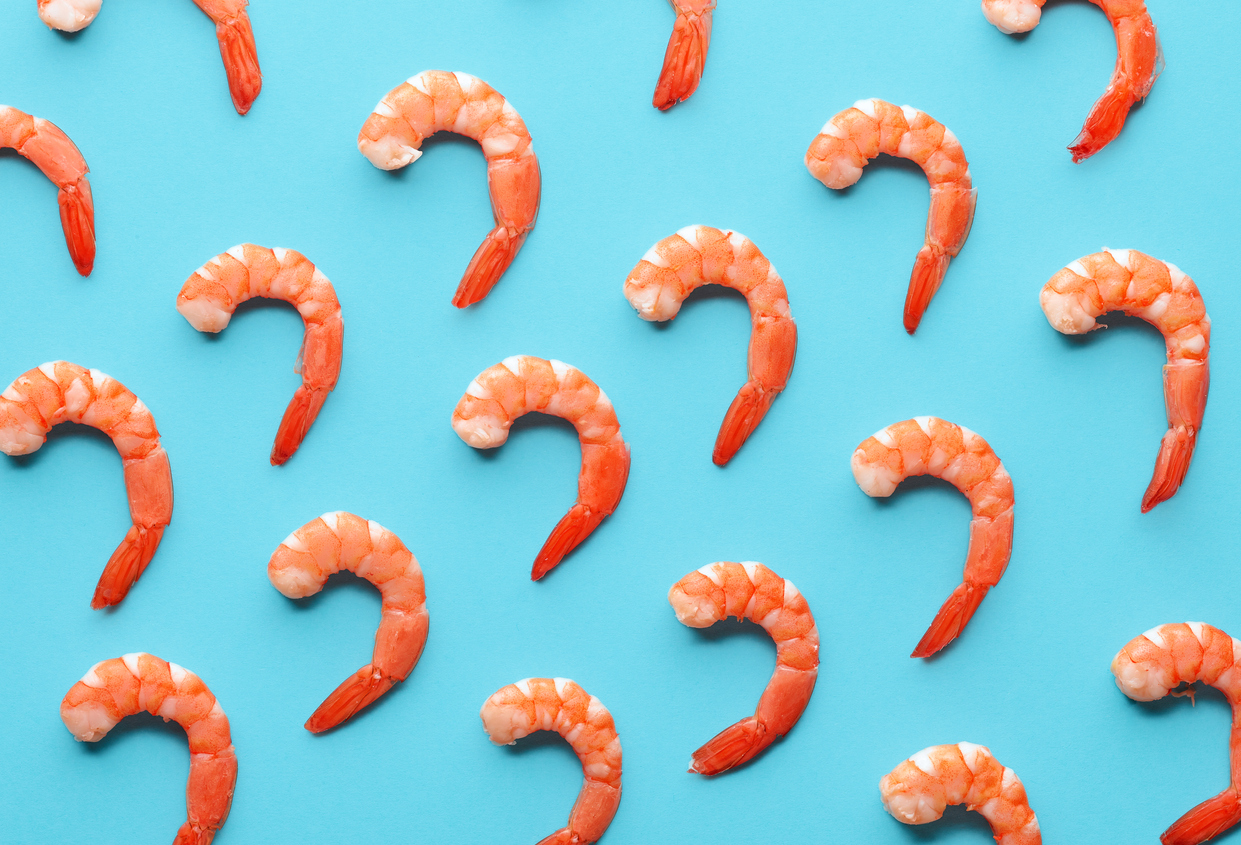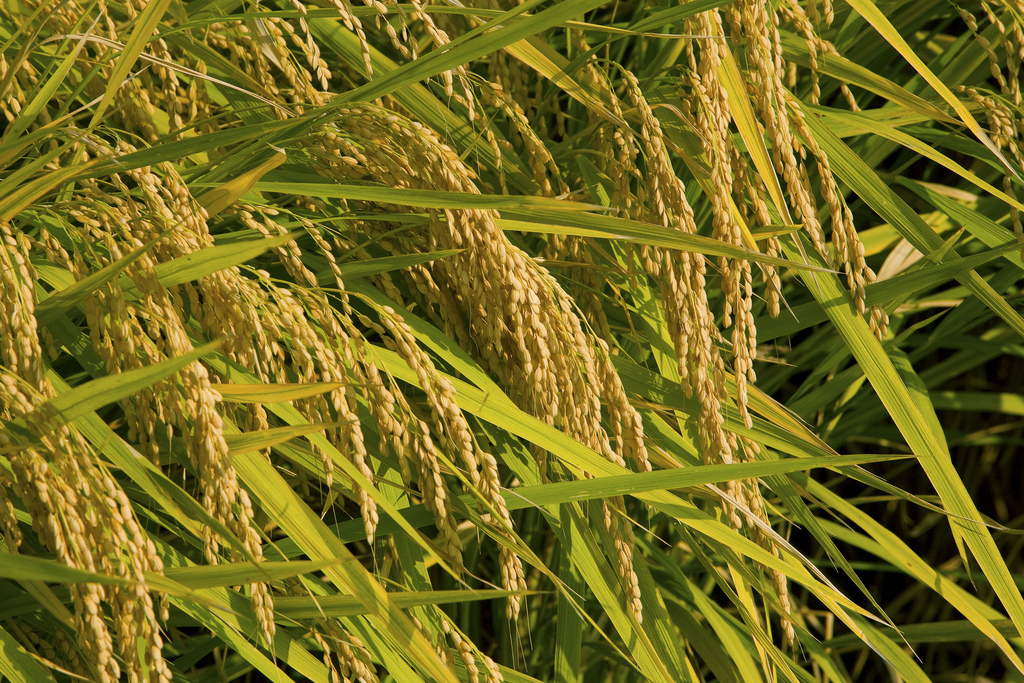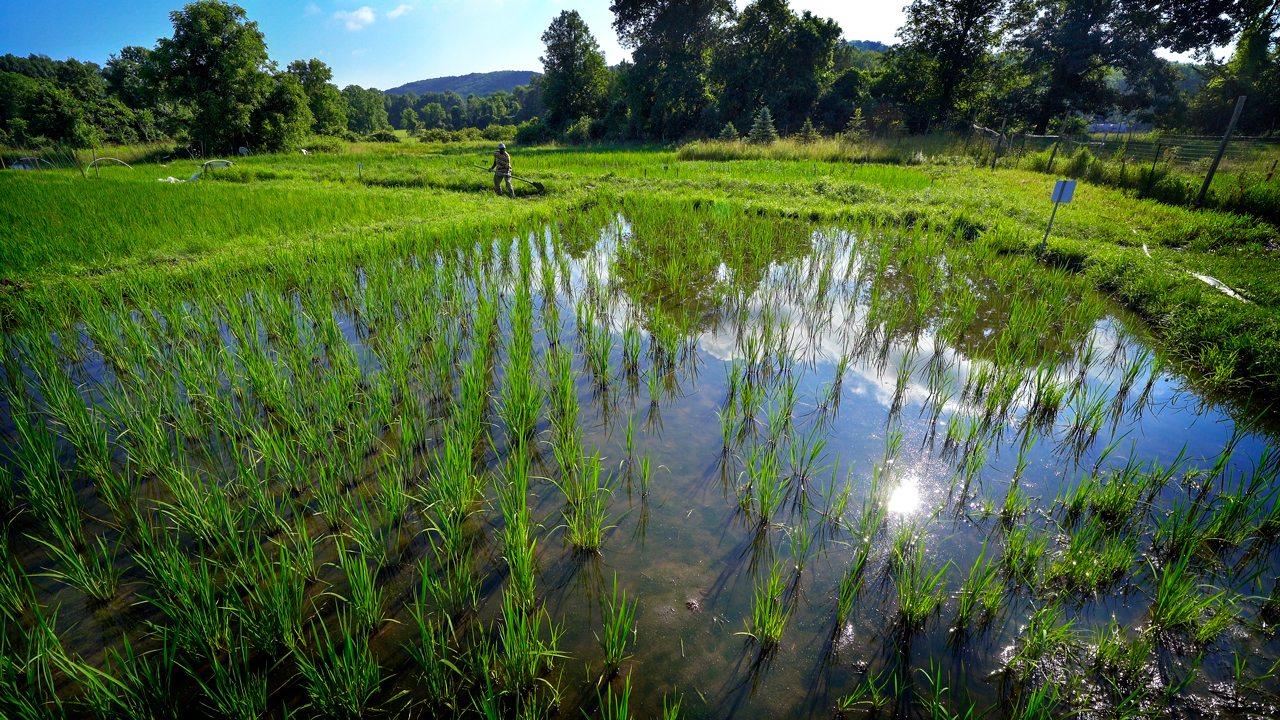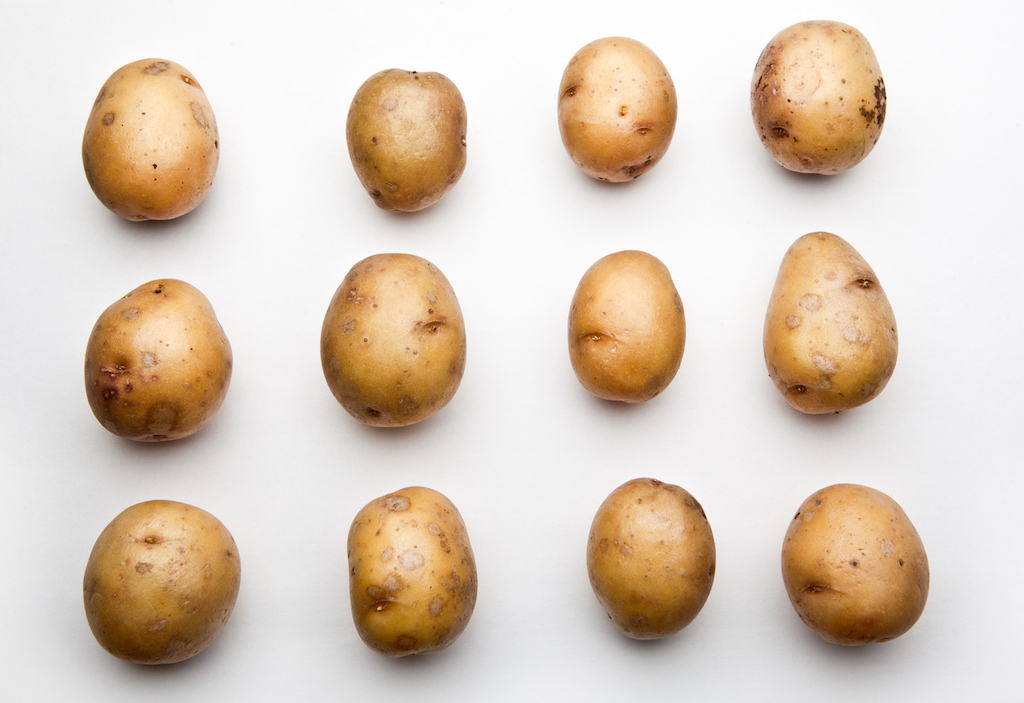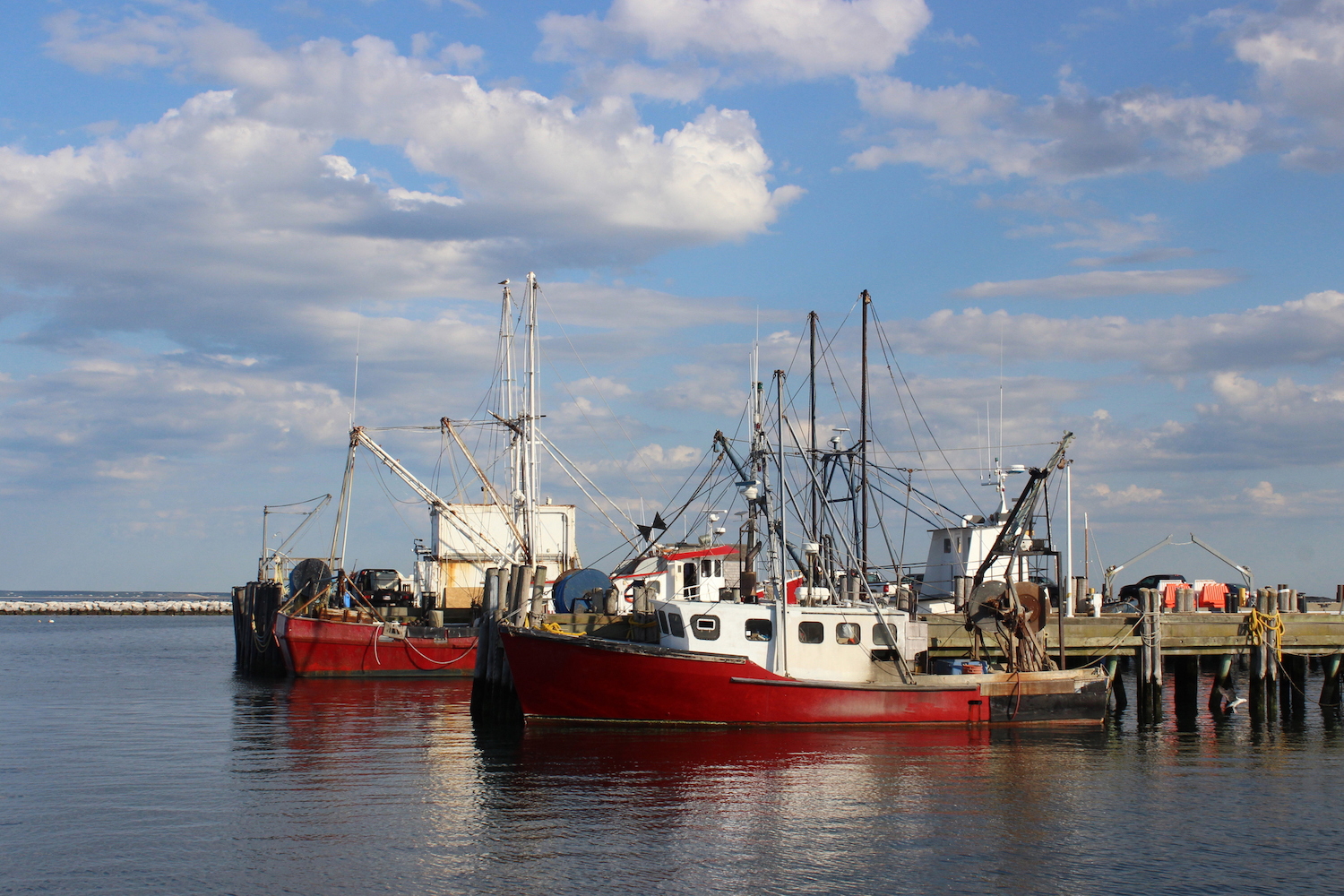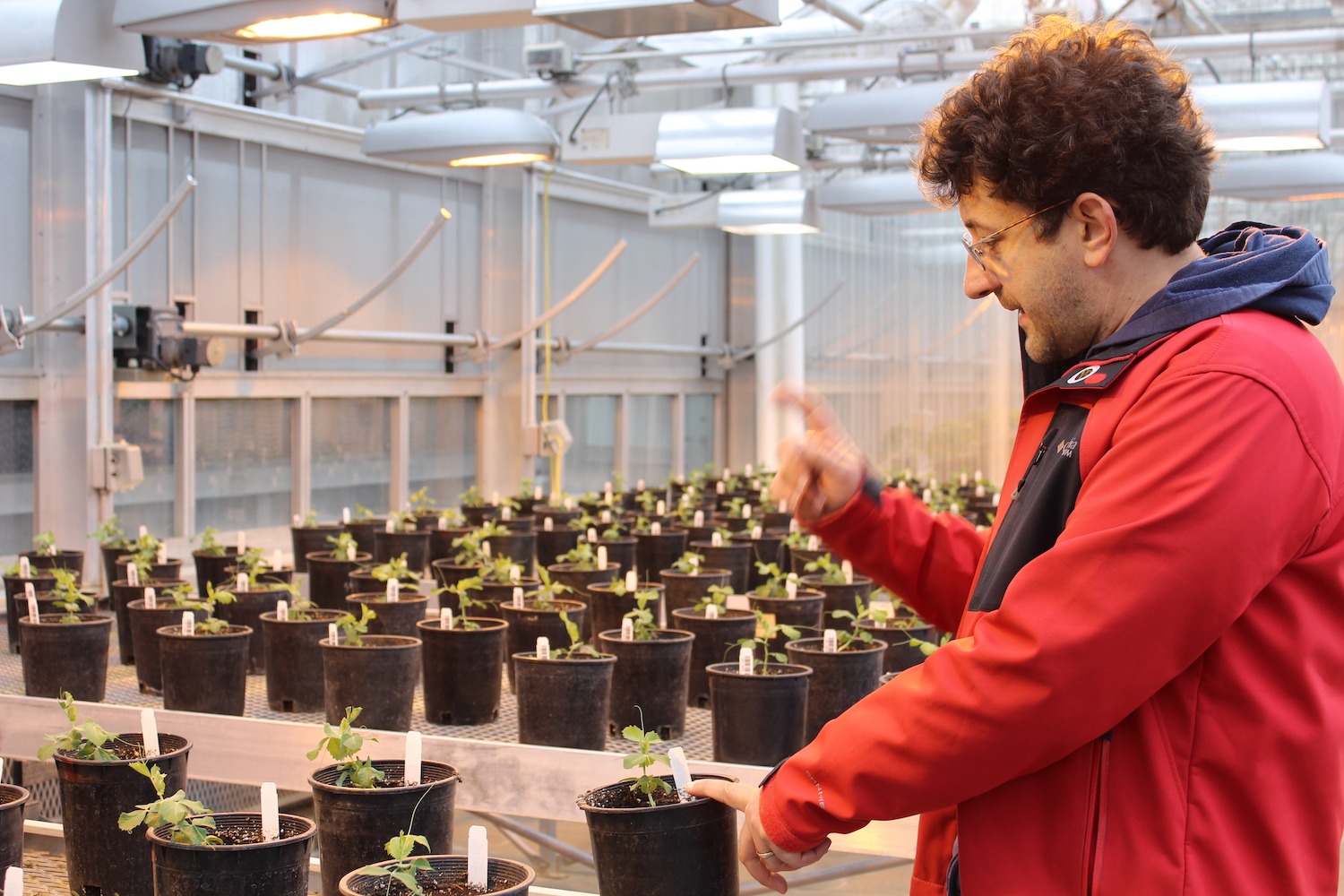
Lela Nargi
A diversity of regionally adapted seeds are in short supply in parts of the U.S. So farmers must increasingly rely on a handful of publicly funded seed breeders to supply them.
Michael Mazourek led the charge through thick-aired greenhouses, cheerfully tallying the destruction. “We inoculated these with a virus,” he said, stopping beside a table topped with stubby squash plants in square plastic pots. Their leaves were anemic and crisp around the edges.
“This was a beautiful disaster,” Mazourek said as he circumnavigated a miniature forest of wrung out pepper plants dangling shriveled fruits. “Our new fancy heaters didn’t work and we had a frost, which is a very climate change-y sort of event.”
Contemplating a spread of bright green tendrils that twisted toward the rainy-day light seeping in through the glass walls: “These peas will get sachets of mites that will hatch out and eat them.” There was jubilant lilt to his doom-laden announcement.
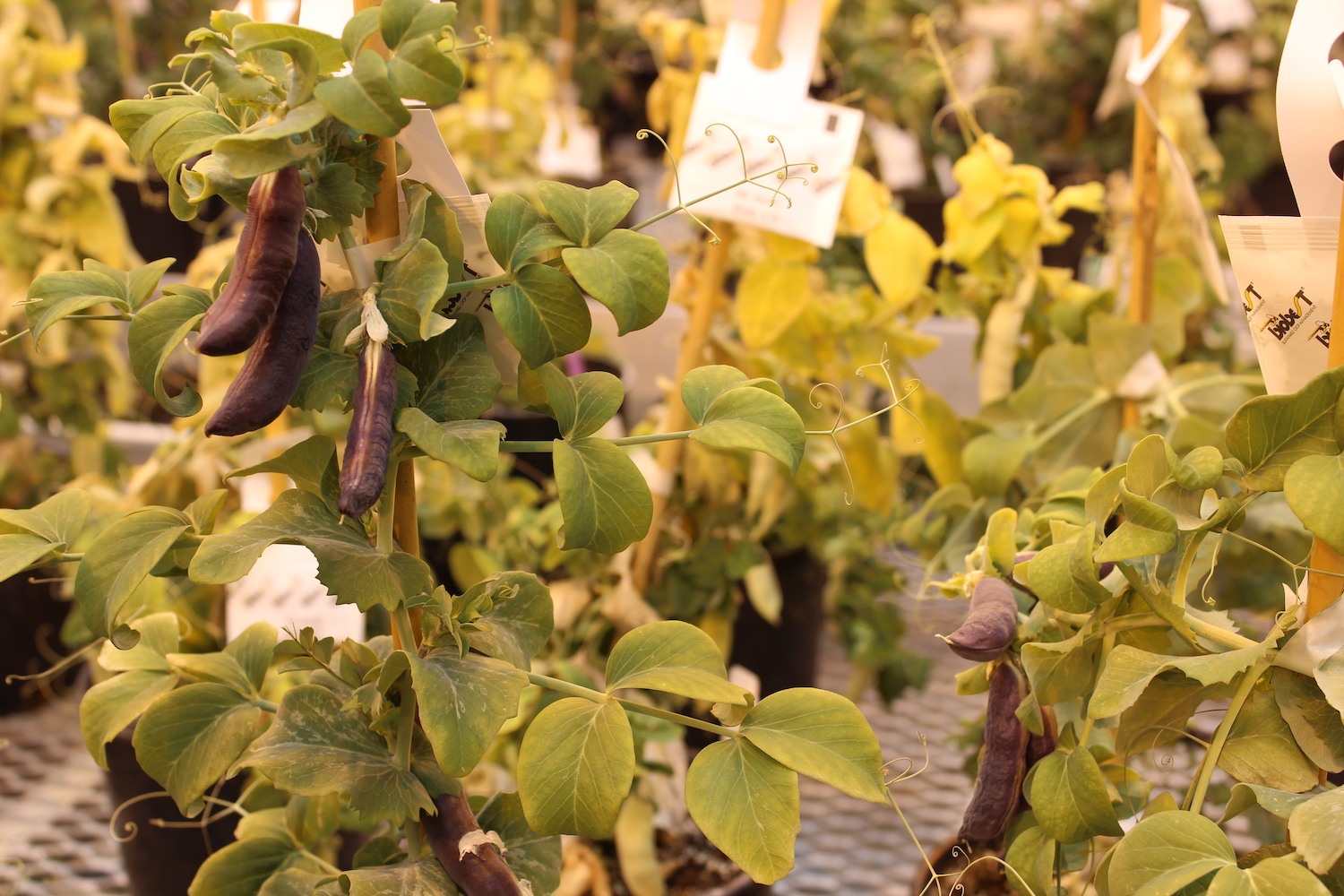
Purple peas could be an important addition to a farmer’s arsenal against climate change.
Lela Nargi
That’s because for Mazourek, an organic vegetable breeder at Cornell University in Ithaca, New York, these and other calamities represent a way forward. If he and his fellow plant breeders across the country can select and cross the right crop varieties, they can give farmers the genetic diversity they need to withstand climate anomalies: early frosts and late heat waves; influxes of new insect pests and diseases; unpredictable seasons.
For generations, North American agriculture has tilted ever more steeply toward a non-localized, chemical-reliant industrial model, where we grow vast monocultures of lettuces in California, corn in Wisconsin, berries in Florida, from seeds developed to work in those regions and cropping systems. It’s a model, said former director general of research organization Biodiversity International in Rome, Emile Frison, “that we know is destroying both the environment and the sustainability of the agriculture system.” By contrast, 70 percent of the world’s population is fed from regional mixed crop food systems, which new research out of Stanford University shows is a buffer against climate change.
Sustainable food advocates, including, recently, Green New Deal proponents, also preach the criticality to food security of this latter equation. Their message has been driven home by the coronavirus pandemic, which Lauren Baker, director of programs at non-profit funding consortium Global Alliance for the Future of Food, said will likely reconfigure the route through which we procure our food. As global supply chains face bottlenecks, we turn to farmers closer to our communities to feed us. And those farmers turn to plant breeders for an ever-evolving roster of regionally adapted seeds that ensure they are up to this task.
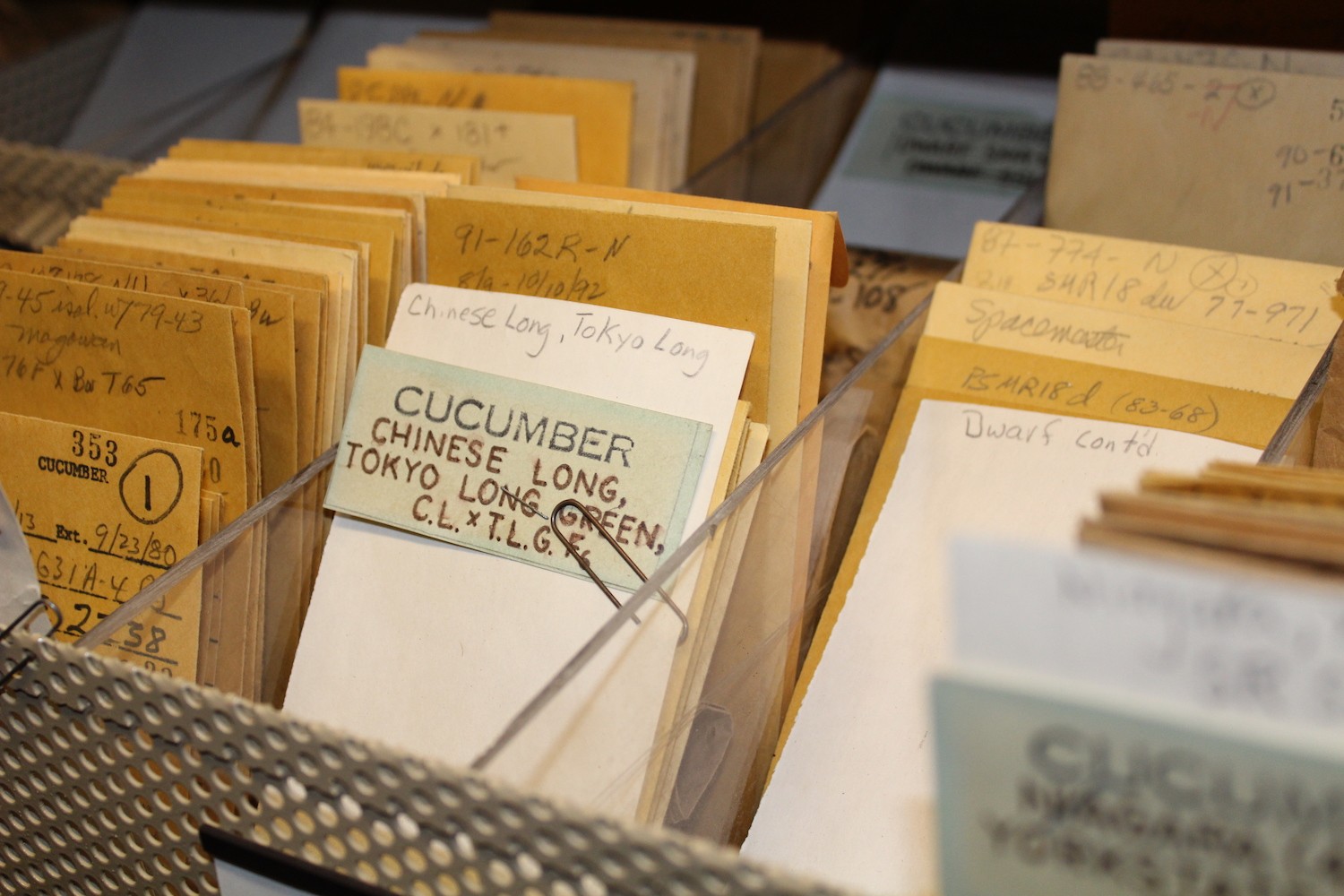
Mazrourek’s seed vault at Cornell.
Lela Nargi
The roots of breeding
Breeding plants is a pursuit that’s almost as old as agriculture, which dates back some 10,000 years. For most of this time, farmers practiced “single line selection,” according to Jack Kloppenburg’s 1988 book, First the Seed. They grew a crop then saved seeds from plants that showed desirable traits—one that bore sweet cucumbers, one that survived when others succumbed to drought. They continued to select seeds from those offspring until they got a whole sweet, drought-resistant crop.
As people moved around, some of the seeds they grew became acclimated to their new environments, showing resistance to a local fungus or producing super-bountiful yields. That’s basically the story of agriculture in North America, where we have few native crops, like blueberries, cranberries, and sunflowers. Beans from South America and okra from Africa became acclimated to the various micro-regions where farmers grew them out. And over time, we got genetically variable populations of plants that could withstand hosts of challenges over a range of climates and conditions.
Mazourek’s method builds on these traditions but is more involved. It’s called recurrent selection. He finds a pepper that’s especially crisp but susceptible to, say, tiny, root-eating roundworms called nematodes. He selects another pepper variety with good nematode resistance and manually cross-pollinates these two “parents.” Like public plant breeders at other land-grant universities, Mazourek works with seed companies, which need products that will grow “true”— produce consistently crisp, nematode-resistant peppers every year. To achieve this, Mazourek selects the best of the offspring and crosses them with each other over and over to “mix in diversity, like stirring and stirring and stirring muffin batter to incorporate it.” Eventually, Mazourek gets a new variety with the beneficial traits of both parents locked in.
“We put little leaves from plants in little tubes, freeze-dry them, and away they go in the mail to a lab that grinds the leaves, extracts the DNA, and sequences it.”
It’s arduous, but he’s got some modern tools to help, like gene sequencing. In selecting parents from his own seed collection, Seed Savers Exchange, seed companies, or the United States Department of Agriculture’s (USDA) veg-heavy gene bank in Ames, Iowa—one of 20 around the country—he needs to make sure they’re genetically dissimilar. That’s how you get diversity, and diversity is how you make sure that one flood, one hail storm, one blight doesn’t wipe out all your peppers. So, Mazourek said, “We put little leaves [from plants] in little tubes, freeze-dry them, and away they go in the mail to a lab [that] grinds the leaves, extracts the DNA, and sequences it.” The resulting information shows him how potential parents are related, and if they should be used as parents at all.
A dearth of resources
Regionally adapted vegetable seeds are in relatively short supply in the Northeast and parts of the Southeast. Many useful and resilient hybrids—crosses between different species whose seeds have to be purchased (rather than saved and replanted) every year because their progeny don’t grow true—became unavailable for breeding when industrial seed companies such as Monsanto and Bayer consolidated and locked up their mutual intellectual property. What was left in the public domain, Mazourek said, were “One-size-fits-most seeds that were adapted to the biggest vegetable growing markets, in California and Florida, which don’t translate from there to here.” It’s worst for organic seeds, the development of which Mazourek said has been vastly underfunded, although he added that a provision in the 2018 farm bill, which dedicates funds for crop development, helps.
Exacerbating these shortages is a dearth of breeders. Mazourek is one of a handful of public breeders specializing in peas, beans, squashes, watermelons, and cucumbers. A colleague on Cornell’s Geneva campus specializes in brassicas and tomatoes. William Tracy, a breeder at the University of Wisconsin-Madison, specializes in sweet corn; he’s one of only two sweet corn breeders in the country. Some crops “have dwindled to almost no public breeders,” Tracy said, leading to a crisis-level “hole in the system for lots of young people trying to get into farming and to find the right crops.” There’s also a backlog in developing materials in gene banks “into quantities that farmers can actually use,” said Biodiversity International’s Frison.
“There’s a pretty rich history of crossing between species and to wild relatives to bring in important traits.”
On the plus side, public breeders can and do tap USDA’s gene banks, which are repositories of wild and cultivated diversity—596,000 accessions strong, of which about 85,000 are vegetable varieties, according to a USDA spokesperson. Some accessions date back to the mid-1800s, when the agriculture branch of the U.S. patent office, pre-USDA, sent out expeditions to collect plant material from around the globe that congressmen distributed to their farming constituents, aiming to improve American agriculture.
Also a plus: “There’s a pretty rich history of crossing between species and to wild relatives to bring in important traits,” said Mazourek. That history is in evidence in his own seed bank, a small cinderblock suite of very cold rooms under lock and key, perched on a muddy hill between greenhouses. Mazourek pulled one metal mesh basket after another off their shelves to show tidy rows of seed packets marked with their name and date of collection and provenance; he’s inherited whole collections, along with lab notes, from breeders who’ve retired or died.
Parent seeds for those disease-inflicted squashes in Mazourek’s greenhouses came from those shelves, a mélange of wild and cultivated varieties.
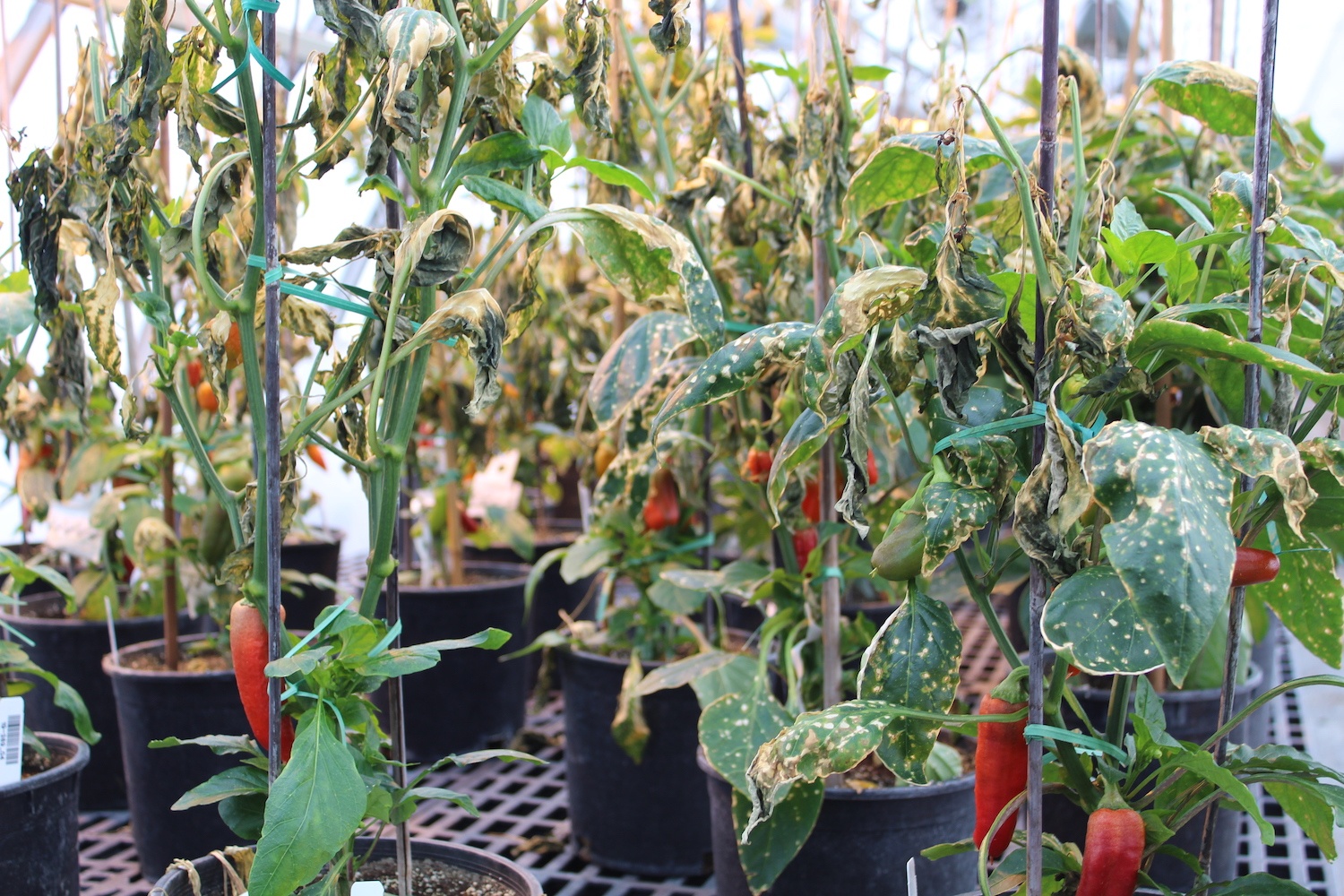
Mazourek’s wilted peppers.
Lela Nargi
Parents of the wilted peppers are a mix of a popular breed called Jimmy Nardello, Corno di Toro, and a wild Serrano, which is good at fending off soil-borne organisms. As the greenhouse heater catastrophe proved, a few of their offspring can survive a freeze, too, a happy accident that Mazourek can tap in future breeding projects.
He’s currently got several pea experiments running, including one to produce purple-colored varieties. “In pea domestication, there was a conscious choice to have all the varieties we eat have white, instead of purple, flowers,” he said. That’s because purple flowers, which generate purple pods, are bitter and astringent so we “clubbed that out of existence.”
But purple peas have other beneficial traits: They can make “a whole repertoire of chemical defenses, and they’re more nutritious, and they also have solar protection” to render them more heat resistant, said Mazourek. Purple peas, beautiful and appealing as they would be to chefs and novelty-seeking consumers, could be an important addition to a farmer’s arsenal against climate change.
Looking for diversity in the wild
The critical need for farmers to prepare for climate anomalies is a talking point everywhere, from the UN’s Food and Agriculture Organization to the regenerative ag community. But “We’re not paying attention to seeds which, along with soil, are the foundation of our food system,” said Global Alliance’s Baker. “We’re taking for granted that we’ll have a healthy seed system on hand, when there’s been a shocking reduction of agricultural biodiversity available for future use.”
While Mazourek and Taylor tinker with seeds sourced from gene banks, some are seeking other avenues to build seed diversity. The Crop Trust, a food security nonprofit based in Bonn, recently completed a project to collect wild relatives of important staple crops in 18 countries, before they become extinct. Wild relatives contain genetics that’ve been lost in many cultivated crops, which makes them valuable resources for breeders and important additions to gene banks.
A number of those newly collected wild seeds have been distributed to labs for pre-breeding. This entails crossing wild millets, eggplants, chickpeas, with existing cultivars, then backcrossing the progeny to the original cultivars, over and over. Traits no breeder wants—small size or a tall, weedy stalk—are gradually removed. Which allows researchers to home in on, and select for, useful traits like heat-resistance and salinity tolerance. After this, plant materials are sent to national and international gene banks, where they’re either stored until needed or developed for use by farmers.
“Looking at novel genetic variation to see if that wild resource has resistance to some pest, tolerance to some stress, a characteristic I can see or measure, that’s how you understand its value.”
Some pre-breeding of wild relatives happens in labs in the U.S. Another Mazourek colleague at Cornell, Susan McCouch, has worked on pre-breeding rice for 28 years. Separate from the recent Crop Trust initiative, she completed a project that used three wild-collected rices from China, Laos, and Indonesia to develop 460 breeding lines. “Looking at novel genetic variation to see if that [wild] resource has resistance to some pest, tolerance to some stress, a characteristic I can see or measure, that’s how you understand its value,” she said.
These lines will be used by government-funded breeders at gene banks outside the U.S. But McCouch has also been training graduate students in her lab all these years, some of whom have gone on to work on rice breeding here in the States. That’s a quieter benefit of her work. Said Tracy, “Collecting things and conserving them is one thing, but if we don’t have public plant breeders, none of this is gonna go anywhere.”
Making seeds
Who’s interested in Mazourek’s frost resistant peppers or his purple peas? Possibly one or more of the 30 Northeastern seed companies he already supplies with plant material.
Maggie Ericksen, contract seed production and marketing manager at High Mowing Seeds in Wolcott, VT, said her company frequently partners with Mazourek, Tracy, and other public breeders, as well as with small and large seed companies in the U.S. and Holland to meet farmers’ volume demands for organic seeds. High Mowing’s latest project with Mazourek is a downy mildew-resistant cucumber called, with a kind of sci-fi blandness, DMR 401. “We didn’t used to get downy mildew in the Northeast but Michael knew it was on the horizon because he saw that it was a problem for growers in the South. Now it’s in New York,” Ericksen said. (Climate change is pushing diseases, pests, weather patterns, northward.)
Mazourek started working on the cucumber 11 years ago and two years ago, High Mowing licensed it from him, paying a 10 percent royalty that goes back into his lab. Sometimes, the company gets the exclusive right to sell a variety, as with a hybrid winter squash from a public breeder at the University of New Hampshire that no one else was interested in. Then they set about conducting two-year field trials. High Mowing might conduct these themselves, or out-source them to farmers, or they might share the burden of a trial with an organization like the Organic Seed Alliance.
Once upon a time in just the 90-mile span between Ithaca and Rochester, New York, this work was shared by dozens of seed companies. Now, this former “biodiversity hotspot” is home to just three.
“We like to do this even when a variety [from a breeder] is considered fully finished,” Ericksen said. “There are so many variables in farming—one year you might have a bumper crop of eggplant and the next year it rains heavily. This way we make sure there’s no fluke.” She said field trialing in an organic system also helps ensure seeds are resilient: “Accustomed to being scrappy, mining for nutrients, holding up to all sorts of weather, as opposed to [conventional] seeds planted in sterile soil and encased in chemicals.”
Sometimes, Mazourek “starts a project based on an idea we share with him, and he’ll make the initial crosses between Parent A and B. Then he’ll advance those [unfinished] resources to us,” said Matthew Goldfarb, co-owner of Fruition Seeds in Naples, New York, which Mazourek has advised since its founding in 2012, as a “public good.” That was the case with the August Ambrosia watermelon that Fruition sells seeds for; but receiving it in an early stage meant it hadn’t been well-mixed, to use Mazourek’s metaphor, “so we had to put on our breeder hat to look at traits and aggressively select for size, thickness of skin, fruit color, sugar content, and ‘watermelon-y-ness,’” Goldfarb said—a multi-year odyssey. Larger seed companies hire their own breeders for this purpose.
After all that, it’s time to grow seeds to make more seeds. High Mowing produces as many as 700 varieties on 40 of its own acres and on 60 other seed farms from Vermont to Kentucky to the Pacific Northwest. Figuring out what to grow when and where is a massive juggle. Squashes, for example, have to be grown at distances of half a mile to keep them from cross-pollinating. Corn needs to be covered with tassel bags to keep varieties pure.

Beans from South America and okra from Africa became acclimated to the various micro-regions where farmers grew them out.
Lela Nargi
Beans and brassicas and onions, with their seeds in separate pods, get cured in a barn for a few months, then undergo “the age-old process of threshing,” said Goldfarb. Peppers and tomatoes and eggplants, with seeds inside wet fruits, are harvested then “run over by a tractor or put through the wood chipper or other tricks.”
Once upon a time in just the 90-mile span between Ithaca and Rochester, New York, Goldfarb’s partner, Petra Page-Mann, says this work was shared by dozens of seed companies. Now, this former “biodiversity hotspot” is home to just three seed companies, only one of which (Fruition) is growing and locally adapting seeds. It’s yet another bottleneck in a deficit-heavy system that’s going to require that we “start questioning how in this time of climate uncertainty we enhance and support that system’s most critical elements,” said Global Alliance’s Baker. That means “increasing our ability to grow out many different varieties of resilient seeds, as well as providing technical support to farmers to help them do that.”
“We definitely need more investment in seed production,” said Ericksen. But still, she’s seen progress. “When High Mowing started, there were only a handful of varieties available as organic seeds.” The company sold 28 in its first year, in 1996. “Thankfully, now we have in the R&D pipeline more varieties than we could possibly look at in a season. That’s a huge shift.” Public breeders, strapped though they are, have helped make this possible. So has a new crop of young people “who are total nerds about breeding and genetics,” Ericksen said. That includes Goldfarb and Page-Mann, and founders of other small regional companies that are starting to move into seed production.
“The more the merrier in the seed world,” Ericksen said. “There’s a lot of work to be done, and we could use some help.”


